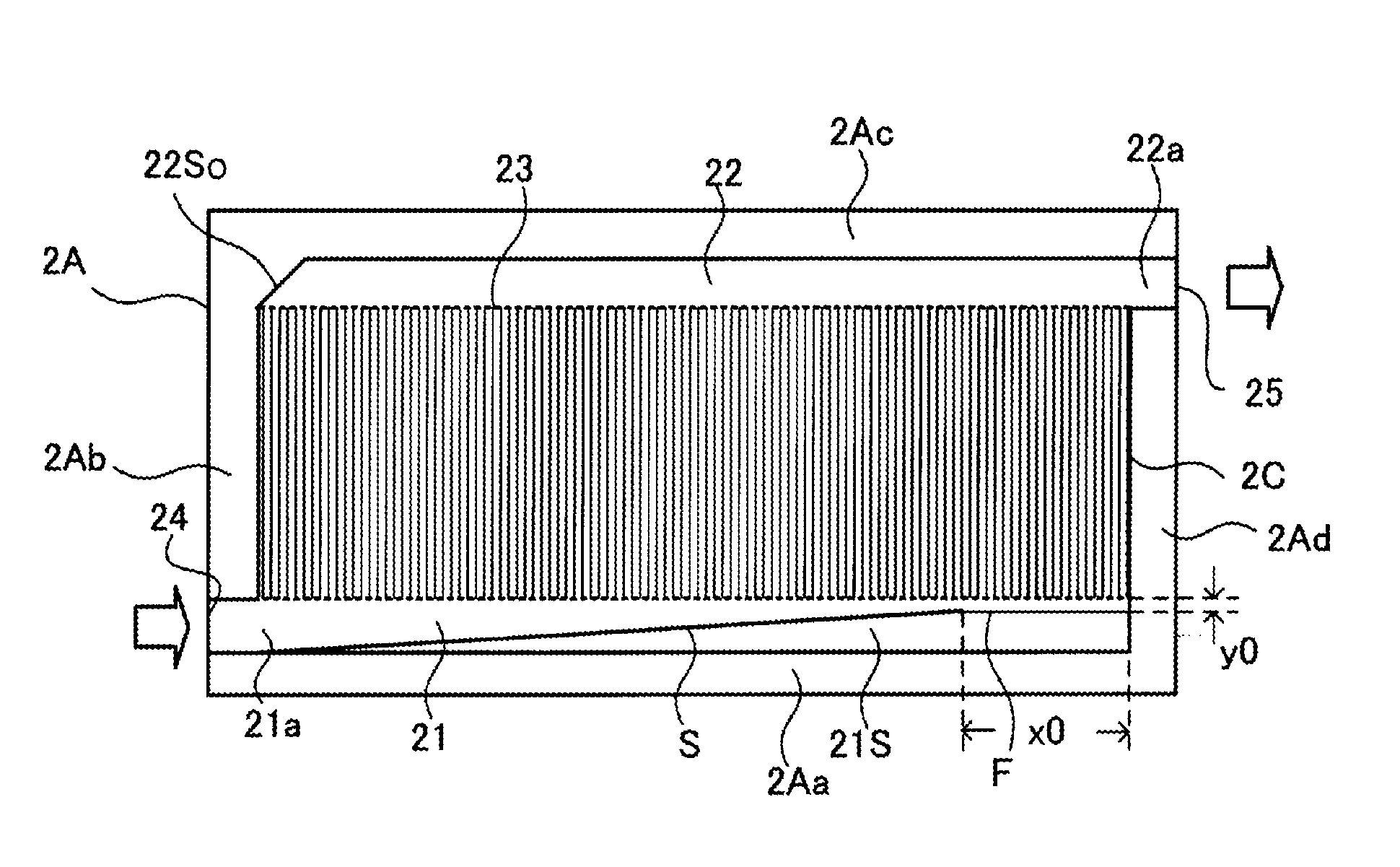Semiconductor module and cooler
a technology of semiconductor modules and coolers, applied in the field of coolers, can solve the problems of increasing the cost of the entire cooler, disturbing the cooling performance balance, and cooling a semiconductor module having a plurality of power semiconductor elements, so as to improve the flow velocity of refrigerant, prevent the increase of temperature, and uniform and stable cooling
- Summary
- Abstract
- Description
- Claims
- Application Information
AI Technical Summary
Benefits of technology
Problems solved by technology
Method used
Image
Examples
first embodiment
[0122]A first embodiment describes the cooler 2 in which the guide part is disposed in the refrigerant introducing passage 21 so as to adjust a drift generated in the semiconductor module.
[0123]FIGS. 11(A) and 11(B) explain a passage structure of the semiconductor module of the present invention FIG. 11(A) is a plan view of the water jacket of the cooler, and FIG. 11(B) is an explanatory diagram showing different structures of the guide part by type.
[0124]First is described a passage structure in which the refrigerant introducing passage 21 is provided with a guide part 21S. In order to improve the flow velocity distribution of the cooling passage 23, the guide part 21S is configured by an inclined surface S having a predetermined inclination and a flat surface F, as shown in FIG. 11(A).
[0125]The guide part 21S of the present embodiment is formed on the front side wall 2Aa of the water jacket 2A, and the inclined surface S and flat surface F that face a front side surface of the hea...
second embodiment
[0147]FIG. 17 is a plan view showing a water jacket of the conventional semiconductor module, wherein the passage structure of the water jacket is different from that shown in FIG. 9. In the diagrams subsequent to FIG. 17, the positions of the refrigerant introducing passage 21 and the refrigerant discharge passage 22 are switched back and forth from those illustrated in FIGS. 2, 9.
[0148]In this embodiment, the introduction port part 21a and the discharge port part 22a project from the left side wall 2Ab and the right side wall 2Ad of a water jacket 2AI, respectively. A tubular pipe or the like is connected to the water jacket 2AI, and the refrigerant sent from the pump flows into the cooler 2 and then flows out of the discharge port part 22a. As with the refrigerant introducing passage 21 shown in FIG. 9, a side wall of the refrigerant introducing passage 21 of this embodiment is configured by the guide wall S1 that is inclined uniformly in the entire range in which the refrigerant...
third embodiment
[0166]Next is described a method for adjusting the drift by forming a step in a height direction in the refrigerant introducing passage 21 to adjust the drift.
[0167]FIGS. 22(A), 22(B) and 22(C) show a passage structure having steps in a height direction in the semiconductor module shown in FIG. 17. FIG. 22(A) is a plan view showing substantial parts of the water jacket of the cooler, FIG. 22(B) is a cross-sectional diagram taken along the arrow L2-L2 in the vicinity of a refrigerant introduction port, and FIG. 22(C) is an explanatory diagram showing the guide part structures by type.
[0168]In the water jacket 2AI of the present embodiment, an inclined member S21 is superposed along the inclined surface of the guide wall S1 in the refrigerant introducing passage 21 configured by the inclined guide wall S1. The guide part configured by the inclined member S21 forms a side wall that is inclined with respect to the front side surface of the heat sink. The inclined member S21 has two incl...
PUM
 Login to View More
Login to View More Abstract
Description
Claims
Application Information
 Login to View More
Login to View More - R&D
- Intellectual Property
- Life Sciences
- Materials
- Tech Scout
- Unparalleled Data Quality
- Higher Quality Content
- 60% Fewer Hallucinations
Browse by: Latest US Patents, China's latest patents, Technical Efficacy Thesaurus, Application Domain, Technology Topic, Popular Technical Reports.
© 2025 PatSnap. All rights reserved.Legal|Privacy policy|Modern Slavery Act Transparency Statement|Sitemap|About US| Contact US: help@patsnap.com



